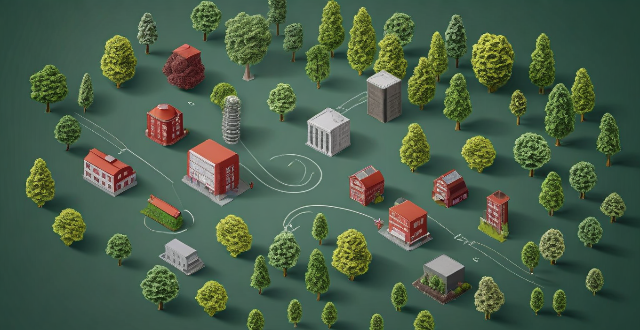Carbon Water

How effective are reforestation efforts in offsetting carbon emissions ?
Reforestation efforts can effectively offset carbon emissions by sequestering carbon dioxide through photosynthesis. Factors influencing its effectiveness include the type of trees planted, location and soil quality, management practices, and timescale. Challenges such as saturation points, land availability, biodiversity concerns, and water resources impact also need to be considered. A balanced approach combining reforestation with other strategies is necessary for meaningful climate change mitigation.

What are the benefits of carbon sequestration in reducing global warming ?
Carbon sequestration helps to reduce greenhouse gas emissions and stabilize climate conditions, leading to improved air quality and public health. It also promotes sustainable development by supporting renewable energy sources and creating green infrastructure. Additionally, carbon sequestration creates job opportunities and stimulates innovation in various industries. In the long term, it preserves biodiversity and prevents extreme weather events caused by climate change.

Can reducing meat consumption lower my carbon footprint ?
Reducing meat consumption can lower your carbon footprint by decreasing the demand for livestock, which produces greenhouse gases and requires significant resources. This dietary change also conserves water and land, improves health, and supports a more sustainable food system.

What is carbon sequestration and how does it work ?
Carbon sequestration is a process that aims to reduce the concentration of carbon dioxide (CO2) in the atmosphere by capturing and storing it. This can be achieved through various methods, including afforestation, soil carbon sequestration, bioenergy with carbon capture and storage (BECCS), direct air capture (DAC), ocean carbon sequestration, and enhanced weathering. The benefits of carbon sequestration include mitigating climate change, improving soil health, restoring ecosystems, and creating economic opportunities. However, large-scale implementation of carbon sequestration projects faces challenges, and continued research and investment are necessary to achieve global climate goals.

How do energy-efficient appliances help decrease carbon footprints ?
Energy-efficient appliances contribute to a smaller carbon footprint by reducing energy consumption, improving efficiency, and having a longer lifespan. Government incentives encourage the adoption of these eco-friendly options, leading to lower energy bills, increased comfort, environmental sustainability, reduced maintenance costs, and enhanced property value. Examples of energy-efficient appliances include refrigerators, washing machines, air conditioners, light bulbs, and water heaters. By choosing energy-efficient appliances, we can all contribute to a greener planet and a healthier future for generations to come.

How is climate change affecting global water resources ?
The impacts of climate change on global water resources include reduced availability due to melting snowpack and glaciers, more frequent droughts and floods, saltwater intrusion into coastal aquifers, and changes in runoff patterns. Water quality is also affected by warmer water temperatures leading to harmful algal blooms, acid rain from increased carbon dioxide levels, pollutant transport from heavy rainfall events, and eutrophication from nutrient loading. The distribution of water resources is impacted by increased water stress in arid regions, migration and displacement of people seeking reliable water sources, strain on infrastructure from extreme weather events, and disruption of aquatic ecosystems due to altered flow regimes. Addressing these challenges requires both mitigation efforts to reduce greenhouse gas emissions and adaptation measures to build resilience against the impacts of climate change on water resources.

How can green technology reduce carbon emissions ?
In this article, we explore how green technology can help in reducing carbon emissions. We discuss renewable energy sources such as solar, wind, hydro, geothermal, and biomass energy, which produce little to no greenhouse gas emissions during operation. We also emphasize the importance of improving energy efficiency and conservation, utilizing carbon capture and storage technologies, and promoting electric vehicles. By implementing these green technologies, we can significantly reduce our carbon footprint and create a more sustainable future for generations to come.

What is carbon capture and how does it work ?
Carbon capture, a technology to reduce CO2 emissions from industrial processes and power generation facilities, comprises three main types: post-combustion, oxy-fuel combustion, and pre-combustion. Each method captures CO2 differently, and the captured gas can be stored or used for other purposes. Carbon capture offers benefits such as reducing greenhouse gas emissions and supporting the transition to a low-carbon economy but faces challenges like high costs and energy requirements.

How effective is a carbon tax in reducing greenhouse gas emissions ?
A carbon tax is a fee on burning carbon-based fuels aimed at reducing greenhouse gas emissions. It creates economic incentives for behavior change, technology innovation, and revenue generation. The effectiveness depends on rate setting, equity concerns, compliance, political feasibility, and international coordination.

What is carbon capture technology and how does it work ?
Carbon capture technology is a set of methods aimed at reducing CO2 emissions from power plants, industrial processes, and other sources. The main types are post-combustion capture, oxy-fuel combustion, and pre-combustion capture, each with its specific techniques and challenges. While these technologies offer significant potential in the fight against climate change, they face economic and logistical barriers such as high costs and the need for safe storage solutions. Ongoing research seeks to improve efficiency and reduce costs, making carbon capture an increasingly viable solution in achieving net-zero emissions targets.

How do climate targets impact agricultural practices ?
Climate targets set by governments and international organizations play a significant role in shaping agricultural practices. These targets aim to reduce greenhouse gas emissions, promote sustainable development, and mitigate the impacts of climate change. The following are some ways in which climate targets impact agricultural practices: 1. Shifting towards Sustainable Farming Methods One of the primary impacts of climate targets is the shift towards more sustainable farming methods. This includes practices such as conservation tillage, integrated pest management, cover cropping, and agroforestry. 2. Adoption of Renewable Energy Sources To meet climate targets, farmers are encouraged to adopt renewable energy sources for their operations. This can include solar power, wind energy, and bioenergy. 3. Changes in Crop Choices and Rotations Climate targets may also lead to changes in crop choices and rotations to adapt to changing environmental conditions and reduce the carbon footprint of agriculture. This can involve planting perennial crops, diversifying crop rotations, and selecting climate-resilient crops. 4. Improved Water Management Water is a critical resource for agriculture, and climate targets often focus on improving water management to reduce water usage and protect water resources. This can involve dripper irrigation, rainwater harvesting, and planting water-efficient crops. 5. Carbon Sequestration and Soil Health Maintaining healthy soils is essential for mitigating climate change, as soils can act as carbon sinks. Climate targets encourage practices that improve soil health and increase carbon sequestration, such as composting, reduced tillage, and intercropping.

What role does renewable energy play in reducing carbon footprint ?
Renewable energy is crucial in reducing carbon footprint as it is obtained from natural resources and does not emit harmful greenhouse gases. It benefits the environment, economy, and society by mitigating climate change, reducing dependence on imported fuels, and providing affordable energy to remote areas. Solar, wind, hydro, geothermal, and biomass energy are types of renewable energy sources. However, challenges such as cost, intermittency, storage, and grid integration need to be addressed. Continued investment and innovation can make renewable energy more accessible and affordable for everyone.

Can environmental subsidy policies help reduce carbon emissions ?
Environmental subsidy policies can help reduce carbon emissions by promoting renewable energy, enhancing energy efficiency, supporting waste reduction initiatives, and funding research and development of carbon capture and storage technologies. However, these policies must be carefully designed and adequately funded to avoid market distortions and ensure long-term sustainability without creating dependence on government support.

What are some examples of carbon offset projects ?
Carbon offset projects are initiatives designed to reduce or offset the emission of carbon dioxide (CO2) and other greenhouse gases into the atmosphere. These projects aim to mitigate the impacts of climate change by investing in activities that remove CO2 from the atmosphere or prevent its release in the first place. In this guide, we will explore some examples of carbon offset projects and how they contribute to the global effort to combat climate change.

What are some of the most effective methods for carbon sequestration ?
Carbon sequestration refers to the process of capturing and storing carbon dioxide (CO2) from the atmosphere to mitigate its effects on climate change. There are several effective methods for carbon sequestration, including afforestation and reforestation, soil carbon sequestration, biochar production, ocean fertilization, and direct air capture (DAC). Afforestation and reforestation involve planting new trees or replacing existing ones in deforested areas, while soil carbon sequestration involves increasing the amount of organic matter in soil by adding compost, manure, or other organic materials. Biochar production involves creating a type of charcoal made from plant materials that is added to soil to improve its fertility and water-holding capacity. Ocean fertilization involves adding iron or other nutrients to the ocean to stimulate the growth of phytoplankton, which absorb CO2 through photosynthesis. Direct air capture involves using machines to capture CO2 directly from the atmosphere and then store it underground or in other long-term storage solutions.

What is the role of renewable energy in achieving carbon neutrality ?
Renewable energy is crucial for achieving carbon neutrality, which involves balancing carbon emissions with offsetting actions. By reducing reliance on fossil fuels and greenhouse gas emissions, renewable sources such as wind and solar contribute significantly to this goal. Renewable energy also promotes energy efficiency, economic growth, and energy independence while mitigating climate change impacts. It supports sustainable development goals and fosters innovation and public engagement in environmental issues. The transition to renewable energy offers long-term environmental benefits, making it essential for a sustainable future with stable climates, thriving economies, and healthier societies.

How can a carbon tax be designed to minimize negative impacts on businesses ?
A carbon tax is a fee on burning carbon-based fuels to reduce emissions and promote clean energy. To minimize its negative impact on businesses, consider gradual implementation, incentives for innovation, clear policy, revenue neutrality, support for affected industries, collaboration, and monitoring. This balances environmental goals with economic realities for sustainable development.

How do carbon credits differ from carbon taxes ?
Carbon credits and carbon taxes are two distinct mechanisms that aim to reduce greenhouse gas emissions and mitigate climate change. While both strategies involve a financial incentive to encourage companies and individuals to reduce their carbon footprint, they operate differently in terms of their structure, implementation, and impact. Carbon credits represent a certificate or a tradable allowance proving that a specific amount of carbon dioxide (or its equivalent in other greenhouse gases) has been reduced, avoided, or sequestered by an emission-reducing project. Companies or countries can earn carbon credits by investing in projects that reduce emissions below a certain baseline, such as renewable energy projects or reforestation efforts. These credits can then be sold to entities that are looking to offset their own emissions or meet regulatory requirements. The price of carbon credits is determined by supply and demand in markets where they are traded. On the other hand, a carbon tax is a fee imposed on the burning of carbon-based fuels (coal, oil, gas) that are responsible for greenhouse gas emissions. Governments set a tax rate per ton of CO2 emitted, which is paid by companies and sometimes individuals using fossil fuels. The goal is to make polluting activities more expensive, thereby encouraging a shift towards cleaner alternatives. Carbon taxes are typically implemented at a national level through legislation. The revenue generated from the tax can be used to fund environmental initiatives or be returned to taxpayers in various ways. Key differences between carbon credits and carbon taxes include their regulatory vs. voluntary nature, direct vs. indirect incentives, and price certainty vs. market fluctuation. Carbon taxes offer price certainty for businesses when planning expenses, while carbon credit prices can fluctuate based on market demand and the success of emission reduction projects. In summary, both carbon credits and carbon taxes serve important roles in addressing climate change, but they do so through different means and with different outcomes.

What are the benefits of carbon offsetting for businesses ?
Carbon offsetting is a strategy that businesses can use to reduce their carbon footprint and mitigate the impact of their operations on the environment. By investing in projects that offset their emissions, businesses can demonstrate their commitment to sustainability and contribute to global efforts to combat climate change. Some of the benefits of carbon offsetting for businesses include reduced carbon footprint, improved reputation and brand image, financial benefits, and stakeholder engagement. By investing in carbon offsetting projects, businesses can demonstrate their commitment to sustainability and contribute to global efforts to combat climate change.

How does deforestation contribute to water cycle disruption ?
Deforestation contributes to water cycle disruption through soil erosion, surface runoff, and groundwater depletion. This leads to droughts, flooding, pollution, water scarcity, and climate change. Sustainable forest management is crucial to mitigate these effects.

Can carbon sequestration be combined with renewable energy sources for maximum impact ?
This text discusses the potential of integrating carbon sequestration techniques with renewable energy sources to maximize their impact on mitigating climate change. It outlines various methods for carbon sequestration, such as afforestation, BECCS, DAC, and ocean sequestration. The text also describes different types of renewable energy, including solar, wind, hydroelectric, geothermal, and biomass energy. It suggests that combining these strategies can lead to synergistic effects, like integrated systems, improved energy efficiency, EVs powered by clean electricity, smart grids, and supportive public policies. Overall, the text advocates for a comprehensive approach that combines carbon sequestration and renewable energy sources to effectively combat climate change.

Are zinc-carbon batteries safe to use ?
Zinc-carbon batteries are a common type of battery used in many household devices, such as flashlights, remote controls, and toys. While they are generally safe to use, there are some precautions that should be taken to ensure their proper handling and disposal. These include avoiding short circuits by keeping the terminals from touching each other or any metal objects, storing them in a cool, dry place away from extreme temperatures and out of reach of children and pets, and disposing of them properly at a recycling center or store that accepts used batteries. Despite these precautions, zinc-carbon batteries offer several benefits, including being cost-effective, widely available, and having a long shelf life.

How can a carbon tax be implemented fairly ?
The text discusses the implementation of a fair carbon tax, which is a fee on burning carbon-based fuels to reduce emissions contributing to global warming. It suggests methods such as progressive taxation, revenue neutrality, renewable energy incentives, public education, phased implementation, and international cooperation to ensure the tax does not disproportionately affect low-income households or certain industries.

What role do carbon emissions play in the greenhouse effect ?
The article discusses the role of carbon emissions in the greenhouse effect, which is caused by certain gases trapping heat from the sun in the Earth's atmosphere. Carbon dioxide (CO2) is one of several greenhouse gases that contribute to this process. Human activities such as burning fossil fuels for energy production and deforestation are major sources of carbon emissions, leading to an enhanced greenhouse effect and global warming. This has resulted in a range of impacts on the Earth's climate system, including rising sea levels, more frequent and intense heatwaves, changes in precipitation patterns, and shifts in ecosystems and wildlife populations. To mitigate these effects, strategies such as transitioning to renewable energy sources and improving energy efficiency are being implemented or proposed. International agreements like the Paris Agreement aim to reduce carbon emissions and limit global temperature rise.

What countries have successfully implemented a carbon tax ?
Countries that have successfully implemented a carbon tax include Canada, Sweden, Finland, Norway, Switzerland, and the UK. These countries have set different rates for their carbon taxes and have seen varying degrees of success in reducing greenhouse gas emissions. While there are challenges associated with implementing such a tax, these countries demonstrate that it can be an effective tool for achieving environmental goals.

What technologies are being developed to help reduce carbon footprint ?
The text discusses various technologies being developed to help reduce carbon footprint, including renewable energy sources such as solar, wind, hydro, and geothermal power; electric vehicles (EVs) with improving battery technology and charging infrastructure; energy efficiency through building design, appliance efficiency, and smart grids; carbon capture and storage (CCS); and nuclear power. These technologies aim to combat climate change by reducing greenhouse gas emissions and promoting sustainable practices.

What are the economic implications of pursuing carbon neutrality for a country ?
Pursuing carbon neutrality has both positive and negative economic implications for a country, including job creation, innovation, energy independence, short-term costs, impacts on traditional industries, and potential carbon leakage.